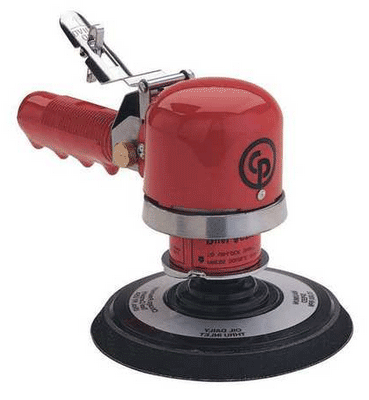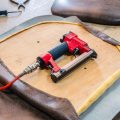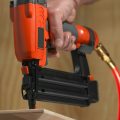Hey! This site is reader-supported and we earn commissions if you purchase products from retailers after clicking on a link from our site.
When selecting an air compressor suitable for sanding projects, there is a lot you must consider to ensure you pick up the right air compressor suitable for the job. This will typically depend on the type of project you intend to conduct, and whether you need intermittent or continuous airflow.
This article will provide you with all the relevant information to help make this selection a lot easier for you!
Table of Contents
- Important Considerations for Selecting an Air Compressor for Sanding
- Examples of Suitable Air Compressors for Sanding
- FAQs (Frequently Asked Questions)
- Reader Comments & Responses
Important Considerations for Selecting an Air Compressor for Sanding
Before you select any air compressor for any project, there are a number of factors you must consider to help ensure you get the most suitable compressor for your work. When selecting an air compressor for sanding, you should pay close attention to the following:
- CFM rating
- PSI capabilities
- Tank size
- Duty cycle
- Power cord length
Each is important in its own way, with some being more important than others. Let’s now take a look at each of these considerations in more detail!
CFM Rating of Air Compressor
In general, sanding should use an air compressor that can produce at least 10 CFM (cubic feet per minute). CFM is a measurement of the volume of air that is moved by an air compressor, if you wish to learn more, please visit our guide here!
Sometimes, you may be able to get away with less than 10 CFM, depending on the sanding tools you’re using with the air compressor to conduct the sanding. In other cases, you may want to have an air compressor that can produce up to and over 10 CFM to be able to comfortably use all your tools continuously.
You’re probably wondering, why have I recommended at least 10 CFM? Well, I base this on that from my research I found multiple sanders readily available on Amazon, that typically had CFM ratings between 5-8 CFM with some having even more. Here is an example of one of those, the Ingersoll Rand 4151 random orbit pneumatic sander.
- VACUUM READY: IR 4151 Ultra Duty Random Orbit Pneumatic Sander connects to central or portable vacuum systems; Whether leveling the top of a wood table or stripping paint from metal, it increases efficiency and creates superior finishes
Prices pulled from the Amazon Product Advertising API on:
Product prices and availability are accurate as of the date/time indicated and are subject to change. Any price and availability information displayed on [relevant Amazon Site(s), as applicable] at the time of purchase will apply to the purchase of this product.
Ingersoll Rand recommends that for optimal performance of this tool, you will need a compressor that produces 8 CFM @ at least 90 PSI. Of course, you may use a different sander that requires less CFM, or a sander that requires more CFM, so, you should base the selection of your air compressor around the CFM requirements of your intended tools!
I initially recommended a 10 CFM compressor as this should be able to power most sanders, but in some cases, you will need an even bigger or more powerful compressor. If you’re wondering how to increase CFM on your air compressor, we have a detailed guide!
PSI Capabilities of Air Compressor
You will need an air compressor that is capable of providing the correct amount of pressure to power your sander. Most air compressor sanders state their minimum and maximum working pressures, along with their optimum pressure.
The Ingersoll Rand sander is rated for 8 CFM at 90 PSI, which the majority of air compressors will be able to comfortably provide. I couldn’t find any information on the minimum and maximum operating pressures of the tool, but I will strongly advise never operating a sander at a pressure below or above the limit if they are specified. This can result in extremely poor performance of the tool, or even potentially damage the surface you’re sanding.
Tank Size of Air Compressor
The tank size of your air compressor for sanding will dictate how much-pressurized air you have available to operate your sanding tools. In terms of the tank, the bigger the better! The more volume you have the more air you will have available at any given time and the less time you will have to wait for the compressor to recycle.
For small intermittent projects, a small portable air compressor with a tank size of 6-10 gallons should suffice. If you wish to conduct continuous sanding, however, and not be disrupted so often, you may need a tank size of around 30-50 gallons. The decision on tank size really depends on the size of your project and how continuously you intend to sand in one sweep!
If air compressor portability is not so much of a requirement, and you have a long enough hose, you could have a stationary air compressor with a 60-100 gallon tank.
Duty Cycle of Air Compressor
An air compressor’s duty cycle rating is typically represented by a percentage, which determines how much downtime a compressor needs during its cycling. For example, a 50% duty cycle, which is very common, represents the need for the compressor to rest for 50% of its cycle time to avoid overheating and premature wear. If the cycle time is an hour, the compressor can work for 30 minutes and then must idle for the other 30 minutes.
Visit our guide here for more information on the duty cycle of an air compressor. The duty cycle is important to be aware of in the case that you desire continuous airflow or are happy with intermittent use.
Hose & Power Cord Length Attached to Compressor
If your air compressor is portable and you can get it outdoors comfortable around your workspace or it may be that you’re sanding a car, then you will need a long enough power cord. The only problem here though is that using an extension cable can dilute the power, depending on the length of it. And so, the compressor may not operate at its optimum.
If the compressor you choose is stationary and not portable, or you don’t wish to use an extension cord, then you will need a suitable length of hose to be able to get the compressed air from your compressor to your project space.
Again, this is not an ideal situation as the longer your hose length becomes, the greater the pressure drop across it, and so, you will need to account for any potential pressure drop to ensure your tools are receiving the right amount of pressure.
Visit our What Size Extension Cord For An Air Compressor guide for more information!
Examples of Suitable Air Compressors for Sanding
I will now provide you with some air compressors for sanding examples that are readily available on Amazon which I believe are suitable for sanding! I’ve split the examples into portable air compressors for mobile sanding, and larger static units for workshops.
Portable Air Compressors for Sanding
What is the best air compressor for sanding? Well, it generally depends on your tools requirements. I have picked out 3 very good examples and justified their selection with the specifications that you should be looking out for during your search.
The first one is this California Air Tools 10020C portable air compressor suitable for small sanding projects.
- Ultra Quiet, only 70 Decibels
Prices pulled from the Amazon Product Advertising API on:
Product prices and availability are accurate as of the date/time indicated and are subject to change. Any price and availability information displayed on [relevant Amazon Site(s), as applicable] at the time of purchase will apply to the purchase of this product.
- HP: 2.0
- CFM: 5.30 @ 90 PSI
- Max. Pressure: 125 PSI
- Tank Size: 10 Gallons
- Weight: 82.5 lbs
This air compressor is capable of producing 5.3 CFM @ 90 PSI, which I know is not enough to power most sanders but I wanted to give an example of a smaller portable air compressor. There are some sanders available on the market that have a CFM below 5.3 and so you will be able to use this compressor.
Another downfall of this wonderful compressor is its 10-gallon tank. This may not offer enough air storage for you to complete your sanding project, so, you may have to accept intermittent use and allow your compressor to keep up with the air demand.
Stationary Air Compressors for Sanding
It may be that you prefer to have an air compressor for continuous use of your air disc sander and powering all sorts of pneumatic tools. And so, here are examples of stationary compressors that would be suitable, based on the considerations I provided earlier in the article.
This NorthStar air compressor is an example of a far larger storage compressor with a 60-gallon tank. The problem with this type of compressor is that it’s stationary, and though it offers a huge amount of air storage to be able to complete your sanding projects, the accessibility to the project may become an issue, and so, lengthy hoses would be required.
- Durable cast iron oil-lubricated pump has one-piece cast iron crankcase and full cast iron cylinder body
Prices pulled from the Amazon Product Advertising API on:
Product prices and availability are accurate as of the date/time indicated and are subject to change. Any price and availability information displayed on [relevant Amazon Site(s), as applicable] at the time of purchase will apply to the purchase of this product.
- HP: 3.7
- CFM: 11.5 @ 90 PSI
- Max. Pressure: 135 PSI
- Tank Size: 60 Gallons
- Weight: 228 lbs
This compressor offers significantly more CFM than the portable compressors presented in this article, and so will be capable of powering the majority of pneumatic sanders.
Another great stationary air compressor option is this Quincy QT-54 splash lubricated reciprocating air compressor.
- Industrial-duty US-made Baldor motor
Prices pulled from the Amazon Product Advertising API on:
Product prices and availability are accurate as of the date/time indicated and are subject to change. Any price and availability information displayed on [relevant Amazon Site(s), as applicable] at the time of purchase will apply to the purchase of this product.
- HP: 5
- CFM: 15.4 @ 90 PSI
- Max. Pressure: 175 PSI
- Tank Size: 60 Gallons
- Weight: 475 lbs
This compressor by far offers the greatest amount of power and will have no issues powering any pneumatic sanding tool!
FAQs (Frequently Asked Questions)
The best size air compressor for sanding will be a stationary air compressor that can provide between 15-20 CFM with a 60-gallon tank so that you’re capable of operating continuously without the frustration of having to allow the compressor to catch up!
Most pneumatic sanders available on the market are rated at around 10 CFM, but some may of course be greater or less. For this reason, it’s advised to have an air compressor that can provide 15 CFM to allow you to provide a sufficient amount of airflow to any sander.
The majority of pneumatic sanders require 90 PSI to run optimally, which all air compressors will be able to comfortably provide.
Additional CFM reading:
- SCFM Vs ACFM Vs ICFM – What’s The Difference? Converting & Calculating
- Best Ways to Increase CFM On Air Compressors
- Connecting Two Air Compressors Together
- How to Calculate CFM of Air Compressors
- CFM Pipe Size Chart
- SCFM vs CFM for Air Tools & Air Compressors Guide to Compressor Ratings
- What Is CFM and What Does CFM Mean on An Air Compressor?
- Air Compressor Size For Spraying Stucco & Plaster
- Does a die grinder require low or high CFM?
- Speedaire 4B247 swapped with 2Z499 and its effect on CFM?
- 20 CFM Air Compressor – Buying, Hiring, What Can They Run?
- Air Compressors That Produce 500 CFM And Above
- CFM SCFM PSI Compressor Flow Issues
- Ingersoll Rand Type 30 model 242 HP and CFM?
- CFM rating of Black Max compressor
What size air compressor:
- What Size Air Compressor Do I Need? How to Size An Air Compressor
- What Size Air Compressor Do I Need For Impact Wrench?
- What Size Air Compressor For Sandblasting?
- What Size Air Compressor For Framing Nailer?
- What Size Air Compressor For Air Hammer?
- What Size Air Compressor For Air Ratchet?
- What Size Air Compressor for Car Detailing?
- What Size Air Compressor for Truck Tires?
- What Size Air Compressor For Nail Gun
- What Size Air Compressor for Painting Cars?
- What Size Air Compressor Do I Need for Spray Painting?
- What Size Air Compressor For Staple Gun Or Upholstery Air Stapler?
- What Size Air Compressor For Sandblasting?
- What Size Air Compressor Do I Need For A Die Grinder?
Reader Comments & Responses
What double-acting air sander(s) can I use with this Air Compressor?
Question
I have a 30-gallon 6.0 HP ohv that runs 8.3 SCFM @ 40psi and I need to know what da sander(s) I can use?
I am completing sanding a car to paint.
Thank you!
Response
My immediate thought is that with the 6 HP you have only produced 8.3 CFM at 40 PSI? That seems pretty low to me.

A 6 HP compressor should give you around 18-20 or so CFM at 90 PSI.
If your compressor is only putting out the flow you say, you will have a hard time running any air tool that requires a greater supply of air at 40 PSI than your compressor can provide, and many air tools prefer 80+ PSI to run properly.
You need to check the production values of the compressor and maybe tell us what the make and model are. You might even upload a photo for us all to see.
Then, check the flow requirements in CFM and PSI for the sander.
If the tool requires less than the compressor can supply, you’re good to go. If it needs more, you’re going to have a problem painting that car.
For guidance on figuring out what size compressor you need for any application or tool, see our guide on sizing an air compressor.
If you’re doing a spraying project and after sanding the car, you’ll be spray painting – visit our guide on sizing an air compressor for spray painting a car.
If you have any questions regarding what compressor you need for a sander, please leave a comment below, with a photo if applicable, so that someone can help you!









